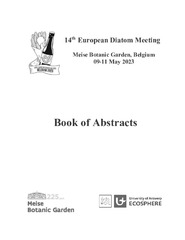Приказ основних података о документу
Metabarcoding and morphological data of Mayamaea species from soda pans in Serbia
| dc.creator | Vidaković, Danijela | |
| dc.creator | Levkov, Zlatko | |
| dc.creator | Krizmanić, Jelena | |
| dc.creator | Beszteri, Bank | |
| dc.creator | Gavrilović, Bojan | |
| dc.creator | Ćirić, Miloš | |
| dc.date.accessioned | 2023-05-21T17:25:04Z | |
| dc.date.available | 2023-05-21T17:25:04Z | |
| dc.date.issued | 2023 | |
| dc.identifier.isbn | 978-9072619-037 | |
| dc.identifier.uri | https://cer.ihtm.bg.ac.rs/handle/123456789/6148 | |
| dc.description.abstract | Soda pans located in the northern part of Serbia are alkaline and very shallow water habitats influenced by seasonal drying. Due to the rareness, vulnerability, and specific biota, these saline habitats have high conservation priority according to the EU Habitats Directive (92/43/EC). Since 2017, ten soda pans have been intensively studied with the aim to determine the diatom biodiversity and to evaluate ecological conditions. Diatom samples were collected from mud and reed, and samples for molecular analyses were additionally collected in 2021. The diatom community is mostly composed of species that prefer alkaline conditions and high conductivity. Some of the most dominant genera are Nitzschia and Navicula. Among the recorded diatoms, Mayamaea permitis and one unknown Mayamaea species were recorded in two soda pans (Okanj bara and Bela bara). The unknown Mayamaea can easily be distinguished from similar species by the valve outline and shape of the central area using light and scanning electron microscopy. In a metabarcoding (partial 18S rRNA gene sequence) data set from the same sample, we could identify two amplicon sequence variants showing affinities to the genus Mayamaea, one of them matching published sequences from M. permitis, the other without exact matches in the Diat.barcode and NCBI databases. We conclude that the latter probably belongs to the new Mayamaea species observed by microscopy, which indicates that the unknown Mayamaea species is closely related to but different from Mayamaea terrestris. Based on morphological features and molecular analyses, we consider the unknown Mayamaea species as a species new to science. Bearing in mind the vulnerability of soda pans due to anthropogenic threats and climate change, knowing which species inhabit these habitats is the first step in preserving these unique ecosystems. | sr |
| dc.language.iso | en | sr |
| dc.publisher | University of Antwerp | sr |
| dc.rights | openAccess | sr |
| dc.rights.uri | https://creativecommons.org/licenses/by/4.0/ | |
| dc.source | Book of Abstracts - 14th European Diatom Meeting, 09-11 May 2023, Meise Botanic Garden, Belgium | sr |
| dc.subject | Soda pans | sr |
| dc.subject | diatoms | sr |
| dc.subject | biodiversity | sr |
| dc.title | Metabarcoding and morphological data of Mayamaea species from soda pans in Serbia | sr |
| dc.type | conferenceObject | sr |
| dc.rights.license | BY | sr |
| dc.citation.spage | 94 | |
| dc.citation.epage | 94 | |
| dc.citation.rank | M34 | |
| dc.identifier.rcub | https://hdl.handle.net/21.15107/rcub_cer_6148 | |
| dc.identifier.fulltext | http://cer.ihtm.bg.ac.rs/bitstream/id/25374/bitstream_25374.pdf | |
| dc.type.version | publishedVersion | sr |


